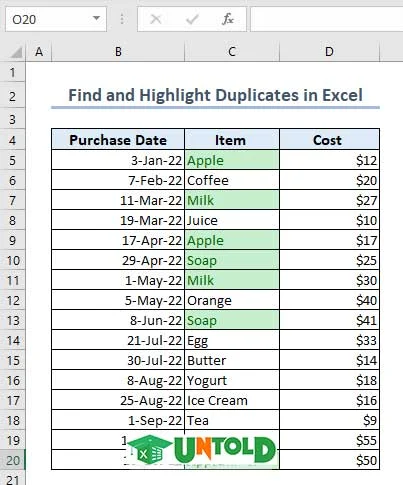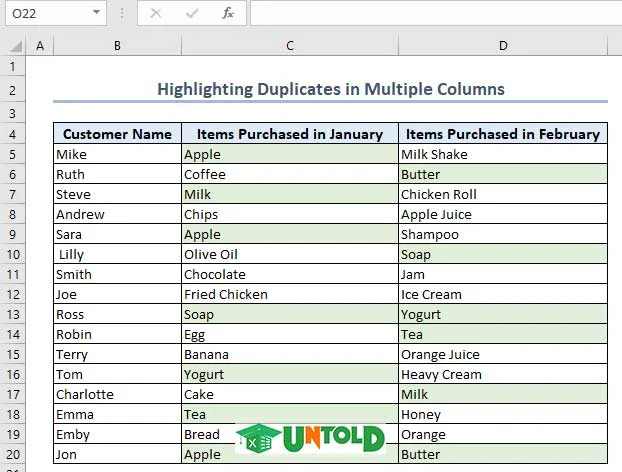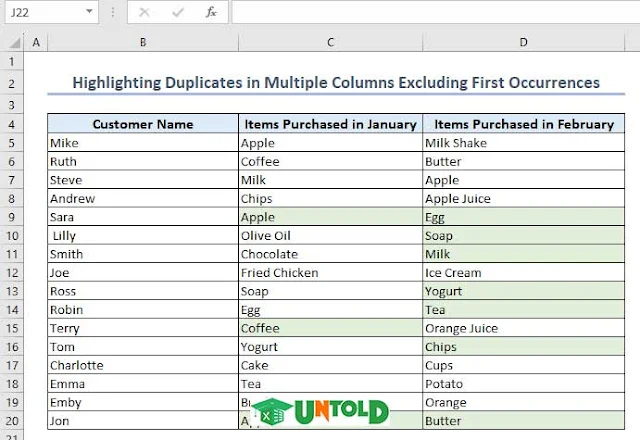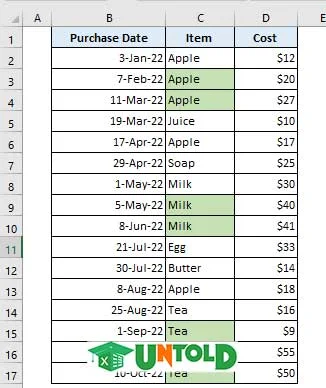Looking for ways to find and highlight duplicates in Excel? Do not worry, we are here for you. In this article, we will describe 3 easy ways to do the task effortlessly. Finding and highlighting duplicates in Excel can be very crucial sometimes. When you are dealing with a large dataset, and have a bulk amount of data, then highlighting duplicates might seem complicated. However, it is rather very easy. This article will describe the task with easy examples and handy methods. So, let’s dive in!
In the following image, you can see the overview of finding and highlighting duplicates in Excel.
Why Do You Need to Highlight Duplicate Values in Excel?
Below we are providing the importance of finding and highlighting duplicates in Excel.
- Making Data Accurate: When there are multiple duplicates of the same data, it can cause mistakes and wrong conclusions. To make sure the information is correct and trustworthy, it’s important to identify and delete any duplicates.
- Saving Time: If you have a lot of information that has duplicates, finding and pointing out those duplicates can help you save time. This way, you can quickly figure out the special values and concentrate on studying them.
- Getting Rid of Errors: In some cases, duplicates can lead to errors in calculations or data analysis. By identifying and removing duplicates, you can avoid these errors.
- Managing Data: Making sure your data is tidy and well-ordered is crucial for managing it effectively. Eliminating copies can aid in keeping your data set organized and efficient.
Overall, It’s essential to identify and mark duplicates in Excel to maintain accurate data, save time, prevent mistakes, and manage your data efficiently.
Find and Highlight Duplicates in Excel: 3 Handy Ways
The following dataset has the Purchase Date, Item, and Cost columns. Here, the Item columns have numerous duplicates. Using this dataset, we will find duplicates and highlight duplicates in Excel.
Here, we used Excel 365. You can use any available Excel version.
1. Finding and Highlighting Duplicates of a Single Column in Excel
Here, we will show how you can find and highlight duplicates of a single column in Excel. We will use Conditional Formatting for this.
1.1 Using Conditional Formatting
Here, we will highlight duplicates with first occurrences.
- First of all, we will select the cells where you need to find duplicates.
- Here, we selected the entire Item column >> go to the Home
- Then, from the Conditional Formatting group >> select Highlight Cells Rule.
- Select Duplicate Values.
At this point, a Duplicate Values dialog box will appear.
- Select Duplicate >> Select a color type.
- Here, we selected Green Fill with Dark Green Text.
- Then, click OK.
Therefore, you can see the highlighted Duplicates with light green color.
Read More: Find Duplicates in Two Columns in Excel
1.2 Find and Highlight Duplicate Rows Without 1st Occurrences
Here, we will find and highlight duplicates in Excel without the first occurrences.
- First of all, we will select the entire Item column >> go to the Home
- Then, from the Conditional Formatting group >> select New Rule.
At this point, a New Formatting Rule dialog box will appear.
- Select Use a formula to determine which cells to format.
- Then, write the following formula in the formula box.
- Then, click on Format.
Then, a Format Cells dialog box will appear.
- From Fill >> select a Color >> click OK.
Then, in the New Formatting Rule dialog box you can see the Preview of the Color >> click OK.
Therefore, you can see the highlighted duplicates in a single column excluding the first occurrences
Read More: Excel Formula to Find Duplicates in One Column
2. Finding and Highlighting Duplicates in a Range of Multiple Columns in Excel
In the following dataset, you can see that we have the Customer Name, Items Purchased in January, and Items Purchased in February columns.
Here, both the Items Purchased in January and Items Purchased in February columns have several duplicates.
Now, using this dataset, we will find and highlight duplicates in a range of multiple columns in Excel.
2.1 Highlighting Duplicates Including 1st Occurrences
Here, we will highlight duplicates in multiple columns including 1st occurrences. We will use the COUNTIF function for this.
- In the first place, we will select the entire Items Purchased in January and Items Purchased in February columns excluding the column headings.
- Then, we will follow the Steps described in Method 1.2 to bring out the New Formatting Rule dialog box and to bring out the formula box.
- Type the following formula in the formula box.
- After that, click on Format and format the cells according to your need.
- Click OK.
Therefore, we have found and highlighted duplicates in multiple columns including first occurrences.
Read More: How to Find Duplicates in Excel Workbook
2.2 Highlighting Duplicates Without 1st Occurrences
Here, we will highlight duplicates in multiple columns excluding 1st occurrences.we will use the combination of IF and COUNTIF functions for this.
- In the beginning, we will select the entire Items Purchased in January and Items Purchased in February columns excluding the column headings.
- Then, we will follow the Steps described in Method 1.2 to bring out the New Formatting Rule dialog box and to bring out the formula box.
- Type the following formula in the formula box.
- Afterward, click on Format and format the cells according to your need >> click OK.
highlighting duplicates in multiple columns excluding first occurrences
Therefore, we have found and highlighted duplicates in multiple columns excluding first occurrences.
Read More: How to Find Similar Text in Two Columns in Excel
3. Finding and Highlighting Nth Subsequent Duplicate in Excel
Here, we will find Nth subsequent duplicates of a dataset in Excel. You can find out 3rd, 4th, or any subsequent duplicates.
For this example, we will show how you can find out 3rd and all subsequent duplicates, and 3rd duplicate only.
3.1 Finding and Highlighting 3rd and All Subsequent Duplicates
Here, we will find and highlight 3rd and all subsequent duplicates of the duplicate Items.
- Select the Item
- Next, follow the Steps described in Method 1.2 to bring out the New Formatting Rule dialog box.
- Type the following formula in the formula box.
- After that, click on Format and format the cells according to your need.
- Click OK.
Note: Instead of 3rd and all subsequent duplicates, if you want to find out the 2nd or 4th, just input 4 in the above formula instead of 3.
Thus, the formula will be
=COUNTIF($C$5:$C5,$C5)>=2, for the 2nd and all subsequent duplicates.
=COUNTIF($C$5:$C5,$C5)>=4, for the 4th and all subsequent duplicates.
Thus, put the order number in the formula according to your needs.
Therefore, you can see the result in the following image.
3.2 Finding and Highlighting 3rd Duplicates Only
Here, we will find out only 3rd duplicates of an Item.
- First of all, select the Item
- Then, we will follow the Steps described in Method 1.2 to bring out the New Formatting Rule dialog box.
- Input the following formula in the formula box.
- Click on Format and format the cells according to your need.
- Click OK.
Note: Instead of 3rd, if you want to find out the 2nd or 4th duplicate, just input 4 in the above formula instead of 3.
Thus, the formula will be
=COUNTIF($C$5:$C5,$C5)=2, for the 2nd duplicate.
=COUNTIF($C$5:$C5,$C5)=4, for the 4th duplicate.
Thus, put the order number in the formula according to your needs.
Finally, you can see the result in the image below.
Highlighting Entire Rows When Only One Column Contain Duplicates in Excel
Here, we will highlight an entire row when only one of the columns of that row contains a duplicate.
In our dataset, you can notice that the Purchase Date and Cost columns contain no duplicates. However, the Item columns contain duplicates. Thus, we will highlight the entire row, based on the duplicate items.
Including First Occurrences:
Here, we will highlight an entire row based on duplicates in one column including 1st occurrences.
- In the beginning, we will select the entire dataset excluding the column headings. Follow the Steps described in Method 1.2 to bring out the New Formatting Rule dialog box.
- Type the following formula in the formula box.
- Then, click on Format and format the cells according to your need >> click OK.
As a result, you can see that for the duplicate items, the entire rows get highlighted.
Excluding First Occurrences:
Now, we will highlight an entire row based on duplicates in one column excluding 1st occurrences.
- We will select the entire dataset.
- Go through the Steps described in Method 1.2 to bring out the New Formatting Rule dialog box.
- Type the following formula in the formula box.
- After that, click on Format and format the cells according to your need.
- Click OK.
As a result, you can see that for the duplicate items, the entire rows get highlighted excluding the 1st occurrences.
Highlight Duplicate Rows Only in Excel
Here, we will highlight duplicate rows. This method is effective when you want to highlight absolute duplicate rows in Excel.
Including First Occurrences:
Here, we will highlight duplicate rows including 1st occurrences.
- First of all, we will select the whole dataset that we are going to apply Conditional Formatting.
- Go through the Steps described in Method 1.2 to bring out the New Formatting Rule dialog box and to bring out the formula box.
- Type the following formula in the formula box.
- After that, click on Format and format the cells according to your need.
- Click OK.
As a result, you can see the highlighted duplicate rows.
Excluding First Occurrences:
Now, we will highlight duplicate rows excluding 1st occurrences.
- In the beginning, we will select the entire dataset.
- Follow the Steps described in Method 1.2 to bring out the New Formatting Rule dialog box and to bring out the formula box.
- Type the following formula in the formula box.
- After that, click on Format and format the cells according to your need.
- Click OK.
You can see the highlighted rows in the following image.
Finding and Highlighting Consecutive Duplicate Cells in Excel
Here, we have consecutive duplicates in the Item column. Now, we will find and highlight these consecutive duplicate cells.
Including First Occurrences:
Here, we will highlight consecutive duplicate cells including 1st occurrences.
- In the beginning, we will select the Item
- Then, following Steps described in Method 1.2, we bring out the New Formatting Rule dialog box.
- Insert the following formula in the formula box.
- Next, click on Format and format the cells according to your need.
- Click OK.
Hence, you can see the highlighted consecutive duplicate cells.
Excluding First Occurrences:
Here, we will highlight consecutive duplicate cells excluding 1st occurrences.
- In the first place, we will select the Item column.
- Then, we will follow the Steps described in Method 1.2 to bring out the New Formatting Rule dialog box and to bring out the formula box.
- Type the following formula in the formula box.
- After that, click on Format and format the cells according to your need.
- Click OK.
thus, you can see the output in the following image.
How to Count Duplicates in Excel
Here, we will count duplicates in Excel.
- To do so, we will type the following formula in cell G5.
- After that, press ENTER.
Therefore, you can see the result in cell G5.
- We drag down the formula with the Fill Handle tool.
Thus, you can see the count of every item including duplicates in cells G5:G12.
How to Remove Duplicates in Excel
In many situations, you might need to get rid of the duplicates in Excel. Here, we will show how you can remove duplicates in an easy way.
In the following dataset, you can see that we have duplicates in the Item column. Now, we will remove the duplicates.
- First of all, we will select the entire Item column >> go to the Data
- From the Data Tools group >> click on Remove Duplicates.
At this point, a Remove Duplicates Warning dialog box will appear.
- Click Expand the Selection >> click Remove Duplicates.
- In the Remove Duplicates dialog box >> mark Item >> click OK.
Here, we marked Item only since only the Item column contains duplicates.
- Then, click OK in the confirmation dialog box.
Therefore, you can see that we have removed duplicates.
Read More: How to Find Duplicates without Deleting in Excel
Things to Remember
- Be cautious to select the correct range of cells before applying Conditional Formatting.
- If the database has merged cells, then we need to unmerge them before applying methods of duplication. Otherwise, Excel can’t find duplicates properly.
- We need to select color, in the Format option of the New Formatting. Otherwise, Excel will give output by selecting duplicates but we won’t be able to see it due to the absence of perfect color.
Download Practice Workbook
You can download the Excel file from the link below and practice the explained methods.
Conclusion
In this article, we extensively describe 3 methods to find and highlight duplicates in Excel. In addition to this, we describe why we need to highlight duplicates.
Furthermore, we show how you can highlight an entire row based on duplicates of a single column, how you can highlight duplicate rows, and how you can find consecutive duplicate cells.
Also, we describe how you can count and remove duplicates.
Thank you for going through the article. We hope this was useful for you. If you have any queries or suggestions, please let us know in the Comment section.







































No comments:
Post a Comment